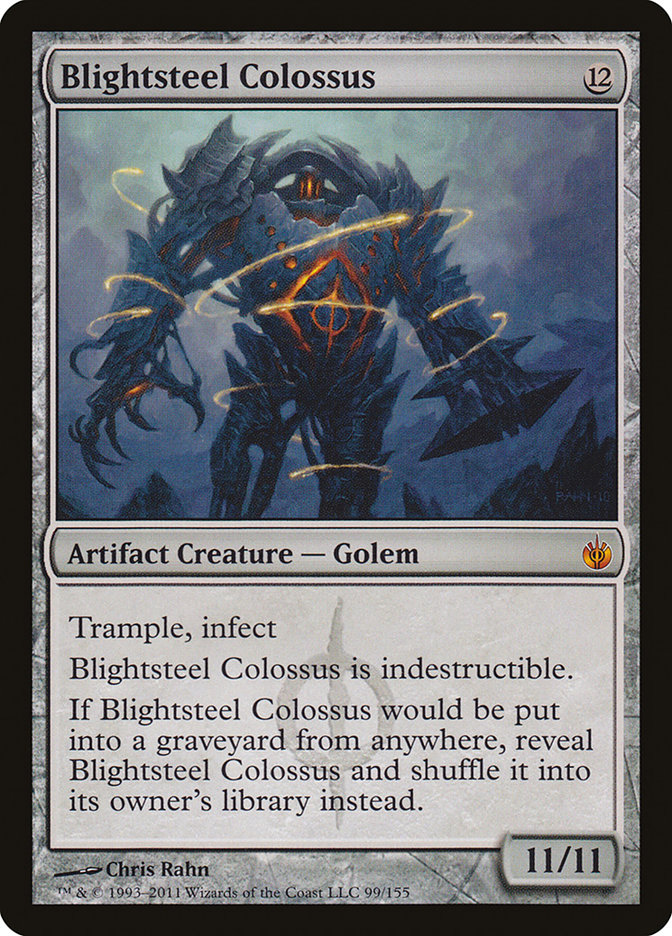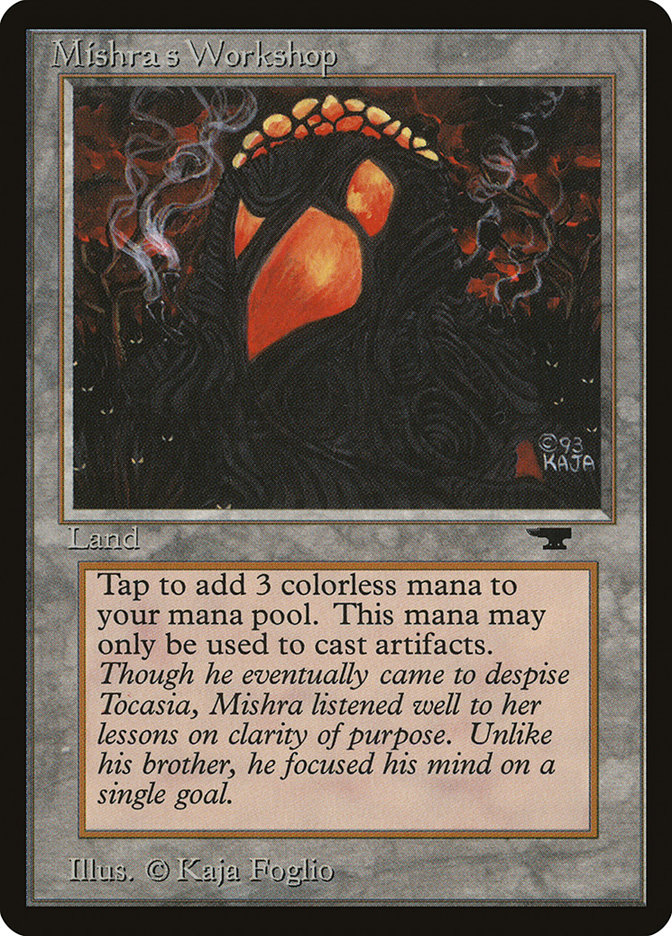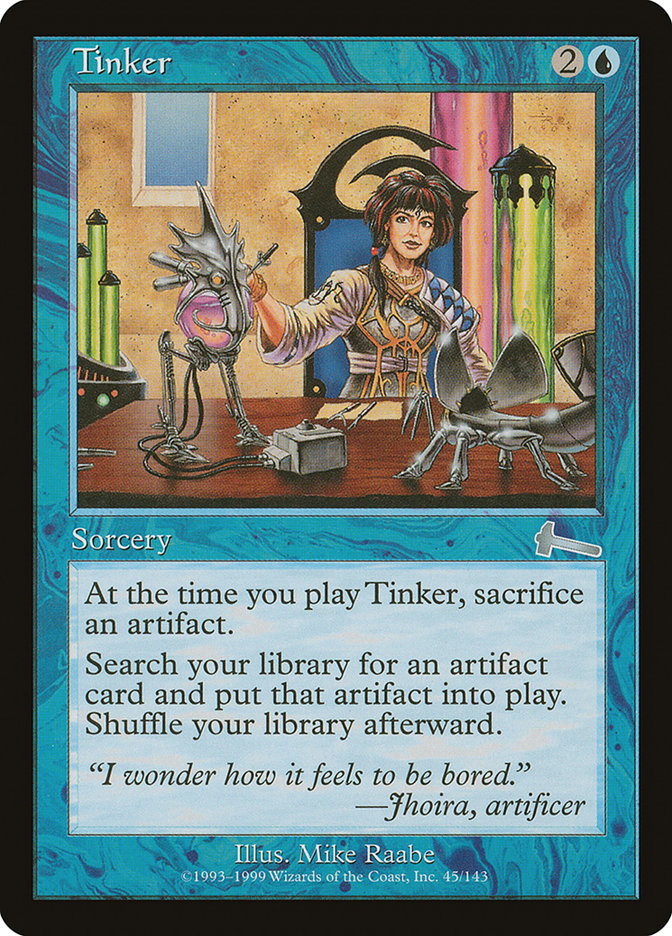Making new decks is a joy of mine. I love the process, I love discovering the constraints of a given format, and I love finding new and interesting ways to
punch holes in deck’s defenses. I’ve been doing this for a while in Legacy, so I wanted to branch out to Vintage for a little bit.
The first part of this process, understandably, was to play a variety of decks. Although I’ve never played a Mishra’s Workshop deck, I’ve played against
enough of them to understand the commonalities and how they differ. Although the only games of Vintage Dredge that I’ve played have been game 1s against
Craig Berry’s BUG Fish deck, I have a decent idea of how the deck tries to win games.
I have very little interest in those two pillars of the format. To be sure, they have powerful centerpieces –Mishra’s Workshop and Bazaar of Baghdad are
incredible cards-but they lend themselves to uninspired and uninteractive games. There is a tremendously high likelihood that any attempt to build a new
deck in the vein of Workshops or Dredge will end up violating the prime operative of brewing, which is to never build a worse version of something else.
Precluding Mishra’s Workshop and Bazaar of Baghdad plus Dredge cards leaves us with only two broad headings – “blue decks” and anti-Vintage decks. If it
gives you some familiarity, think of these as roughly comparable to “Brainstorm decks” and “Maverick/Junk decks”. It is self-evident that Delver of Secrets
decks are very different from Shardless Agent decks, each of which are different than Storm or Show and Tell. The reason why all of these decks form one
larger heading is that they are necessarily built in reaction to the other two pillars of the format. Let me take some time to elaborate on that and how it
differs from Legacy.
In Legacy, the fastest things you can do are typically beatable with a Force of Will. In many other cases, they are beatable without a Force of Will but
with a Thoughtseize into something else or a turn 2 Thalia, Guardian of Thraben. Disruption on turn 0 isn’t as important because not every deck is
presenting a game-defining threat (or potential kill) on turn 1. In Vintage, that is not the case. With the presence of Black Lotus, various Moxen, and
other powerful mana accelerants comes a higher density of turn 1 power plays, and so Force of Will’s value is far higher due to its ability to interact on
turn 0.
Non-blue decks, therefore, have to have a compelling reason to exist given the format’s capacity to produce game-breaking plays on turn 1. Workshop and
Bazaar are those compelling reasons. Workshop provides a Lands-style prison angle that plays thirteen “Thalias” – Sphere of Resistance, Thorn of Amethyst,
Lodestone Golem, and the restricted Trinisphere, while Bazaar provides a turn 2 or turn 3 kill via an uncounterable threat – a land’s activated ability.
This land is so important that the deck plays Serum Powder for the sole purpose of creating a greater number of hands that can access a Bazaar of Baghdad.
Whereas “having a Dredge card” is the litmus test for a keepable hand in Legacy, the standard in Vintage is “do I have a Bazaar of Baghdad?”
A “control deck”, therefore, can reasonably be defined as any deck that isn’t pursuing a turn 1 kill, a turn 1 Bazaar, or a turn 1 Mishra’s Workshop. A
turn 1 kill deck is obviously a powerful linear strategy that seeks to pressure an opponent’s keep. A turn 1 Bazaar of Baghdad fuels a powerful linear
strategy that tries to ignore what an opponent is up to. A turn 1 Mishra’s Workshop churns out any of a number of lock pieces that tax an opponent’s
capacity to play spells for the rest of the game. A control deck necessarily must be built in reaction to these three realities. Many control decks choose
to ignore Dredge decks altogether and instead dedicate significant sideboard space and postboard mulligan discipline to beating them with counter-haymakers
like Leyline of the Void and Yixlid Jailer. Other control decks accept a poor game 1 against Mishra’s Workshops but sideboard into any number of Ancient
Grudges, Trygon Predators, Hurkyl’s Recalls, Steel Sabotages, Nature’s Claims, and other flexible yet decidedly Workshop-antagonistic cards.
In my limited experience of Vintage, combo decks and control decks can share a great many elements. I have encountered situations in which a deck can play
a control-oriented game for several turns, draw a game-changing card, and take a minutes-long turn that (almost incidentally) concludes the game. Take, for
example, the Cobra Fastbond deck that I played last week. When does
that deck become a combo deck?
It plays a bunch of card draw and countermagic. For several turns, it can sit around and play defense, countering threatening spells. At any point, it can
draw Gush plus Fastbond with Lotus Cobra in play and “go off” in such a decisive manner as to win the game. It doesn’t play Gush with the express purpose
of “trying to go off on turn 4” like a traditional combo deck.
This functionality exists in so many blue decks, and in such a diverse range of blue decks, that it can hardly be called coincidental. There is a reason
why blue decks are built to have access to a number of knockout plays, even when other elements point to their pursuit of a controlling role in many
matchups. It sounds so obvious as to not be worth stating, but I’ll point it out regardless:
The top of your opponent’s deck is far more threatening in Vintage than in any other format.
The presence of restricted cards is a huge motivator for any deck to close games out quickly. Rather than try to play a huge range of specific answers to
various strategies, blue control decks are incentivized to build toward knockout or lockout endgames. Knockout endgames include plays like Tinker into
Blightsteel Colossus plus Time Walk, Tinker into Time Vault plus Voltaic Key, or Yawgmoth’s Will with a stocked graveyard. Lockout endgames tend to involve
having more countermagic in hand than your opponent has cards in hand. If your deck doesn’t build toward an endgame involving one or the other, it’s always
just one Kuldotha Forgemaster, one Tinker, one Wheel of Fortune, or one Oath of Druids away from a winning position flipping into a losing one.
Enough theorycrafting for now. Let’s talk about my (debatably) sweet idea for a deck!
The primary lockout deck in the format is Mishra’s Workshop, right? It plays a card that is basically a Black Lotus every turn and then trades 33% of that
card’s functionality for 100% of an opponent’s land’s functionality. In conjunction with enough Spheres and Thorns, Mishra’s Workshop serves as a triple
Stone Rain. When you don’t draw Workshop, you still have Ancient Tomb. You also play Wasteland, Rishadan Port, and the restricted Strip Mine to further
constrain an opponent’s manabase. If that wasn’t enough, Chalice of the Void is typically set to zero to lock out Moxes and Black Lotus, which are typical
parts of Vintage manabases.
Without Mishra’s Workshop and Ancient Tomb, however, the mana advantage of a Workshop deck disappears, and with it the biggest incentive to play
symmetrical mana constraints. Everyone tries to attack Mishra’s Workshop decks by attacking their action. I’ve done a good amount of research on this, and
it doesn’t look like anyone tries to attack their mana. We’ll come back to this.
Dredge mulligans to Bazaar of Baghdad, right? It anticipates taking a lot of mulligans with the express purpose of finding a Bazaar of Baghdad, playing it,
and activating it several times. If its Bazaar didn’t work, it would sit around for several turns before it could play the discard-then-dredge game. Those
turns of inaction would be lethal.
Blue decks tend to play a ton of nonbasic lands. It’s mostly a freeroll to play nonbasics in Vintage given that Workshop decks primarily attack artifact
mana and few other decks play Wasteland. Besides, a bunch of blue decks play Library of Alexandria and Tolarian Academy, so it’s not like there’s a ton of
utility to playing more than one or two basics – you mostly just want them there to fetch up against Workshop decks where your draw is exceptionally
vulnerable to Wasteland.
You all get where this is going.
One of the biggest draws to Blood Moon in Vintage, for me, is that artifact acceleration is so much better than in Legacy. If you want, you can
play all of the acceleration that Legacy offers plus Sol Ring, Mana Vault, Mana Crypt, five Moxen, Black Lotus, and Tolarian Academy (in a world where you
always draw Mox Ruby). That’s an absurd volume of acceleration to support a turn 1 Blood Moon. As an added bonus, Simian Spirit Guide gets around the
restrictions of all Spheres and Thorns.
We can further the mana-denial aspect of the deck by playing Gorilla Shaman. Although he will primarily be on Mox-munching duty, I can envision a world in
which he goes bananas (ha!) and starts eating Spheres and Thorns and Time Vaults. A similar argument can be made for Goblin Welder, albeit in a more
constructive role than Mox Monkey. We’ll return to the red one-drops, but suffice it to say that some of them are making it in.
One of the classic tradeoffs of having an explosive manabase in the early game is that it is weak as the game drags on. Since this is Vintage, however,
there are ways to mitigate that drawback. Since so many of our cards have diminishing returns – additional copies of Blood Moon or Magus of the Moon,
Simian Spirit Guides and so on – it stands to reason that we will be able to maintain a reasonable hand size. This “resource” opens the door for a powerful
tutor that, to my knowledge, sees next to no play in Vintage.
It is pretty obvious why tutors are better in Vintage, so I won’t waste your time on that. Once we’re playing four Gambles though, we start wanting a
number of game-winning cards to Gamble for. Let’s go!
We did it! Gamble for Tinker is going to be good enough about 80% of the time. In a world where we have Goblin Welder, we can also Gamble for Time Vault or
Voltaic Key and be able to Weld either card in.
Where does that put us so far?
4 Gamble
1 Mox Ruby
1 Mox Jet
1 Sol Ring
1 Tinker
We’re at 28 cards so far, with eleven of those being mana sources and four of those being red sources. I’d like to have somewhere in the range of 14-16 red
sources and 24-25 mana sources in our turn 1 Blood Moon deck, so we want roughly eighteen more spells and fourteen more mana sources. I don’t love Magus of
the Moon because of the prevalence of creature kill nowadays (especially Lightning Bolt), and I don’t love going deep on Simian Spirit Guide because at the
end of the day, it’s still just a Lotus Petal.
In order to make this deck better than a Mishra’s Workshop lockout-oriented deck, I think we’re going to have to play Force of Will and all of the busted
blue cards. Tinker and Ancestral Recall are obvious fits with all of the cantrips being reasonable additions after that. It might just be the case that
this turns into a Blue Moon-style deck with the ability to go late with Goblin Welder and Jace, the Mind Sculptor.
If we accept a paradigm of needing roughly seventeen blue cards for Force of Will, we’re already nearly at the point where we have to include only blue
spells from here on out. I think including Blightsteel Colossus is fine as our Tinker robot, although we’re committed to including seventeen blue spells
after that. After four Force of Wills, we’re at thirteen. After Ancestral Recall and Time Walk, we’re at eleven. After Brainstorm and Ponder, we’re at
nine.
From here, I think I’d like five counterspells and four planeswalkers given the density of acceleration in the deck. Since this deck is going to struggle
to hold up double blue, I’d like to stay away from too many Mana Drains. Now as ever, I welcome the input of you, but I’m leaning toward three Mental
Misstep, one Mana Drain, and one Pyroblast for the counterspell section. It’s possible that another Pyroblast is better than a Mental Misstep, but I’ll
leave that to you.
The planeswalkers are an easier choice. Once you’re Gambling, you might as well enlist the help of the greatest thief in the multiverse. Well, that and
Goblin Welder gets better, the dead topdecks can get filtered away, and the deck becomes even more artifact-antagonistic. Tezzeret the Seeker is an easy
inclusion with Time Vault and Voltaic Key, and two Jace, the Mind Sculptor round out the deck nicely.
The lands are fairly simple: you don’t want more than one basic Mountain, you want the maximum number of basic Islands, and you want a ton of fetchlands
for two Volcanic Islands. With fourteen land slots available, the breakdown is:
1 Mountain
3 Island
The finished product, therefore, is:
Creatures (9)
Planeswalkers (4)
Lands (14)
Spells (33)

Do I know whether this deck will be good? Absolutely not. It might just be a worse version of Control Slaver or Turbo-Tezzeret. However, I think that Blood
Moon is a card worth exploring in competitive Vintage.
The sideboard for this deck is fairly straightforward: it wants Pyroblasts against blue decks, more planeswalkers and some number of Pyroclasms against
Fish-style decks, Vandalblasts against Workshops, and Grafdigger’s Cages against Dredge. Cage shuts off Oath and Dredge without harming our Tinkers (since
we can just Tinker away the Cage when the time comes), which is ideal. It does hurt Goblin Welder, but we can also use it in conjunction with Goblin Welder
to construct our own pseudo-Visara for their artifacts.
My proposed sideboard is then:
Is this deck good? No clue.
Is it sweet? Yeah, definitely.
Could it be improved? Only if you tell me how.
Seriously though, I can’t wait to make some videos with this.





